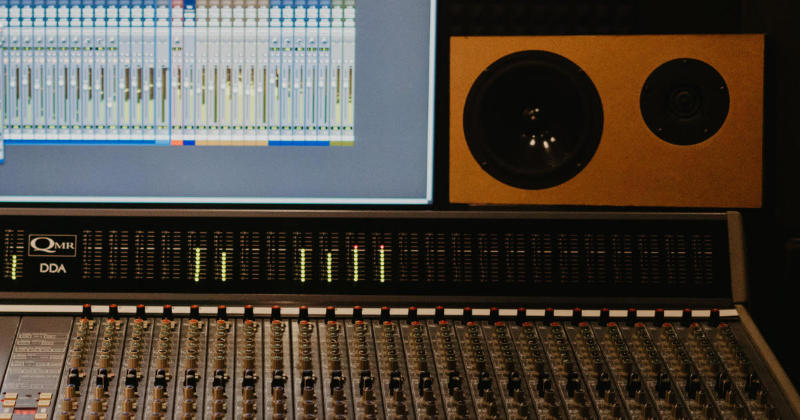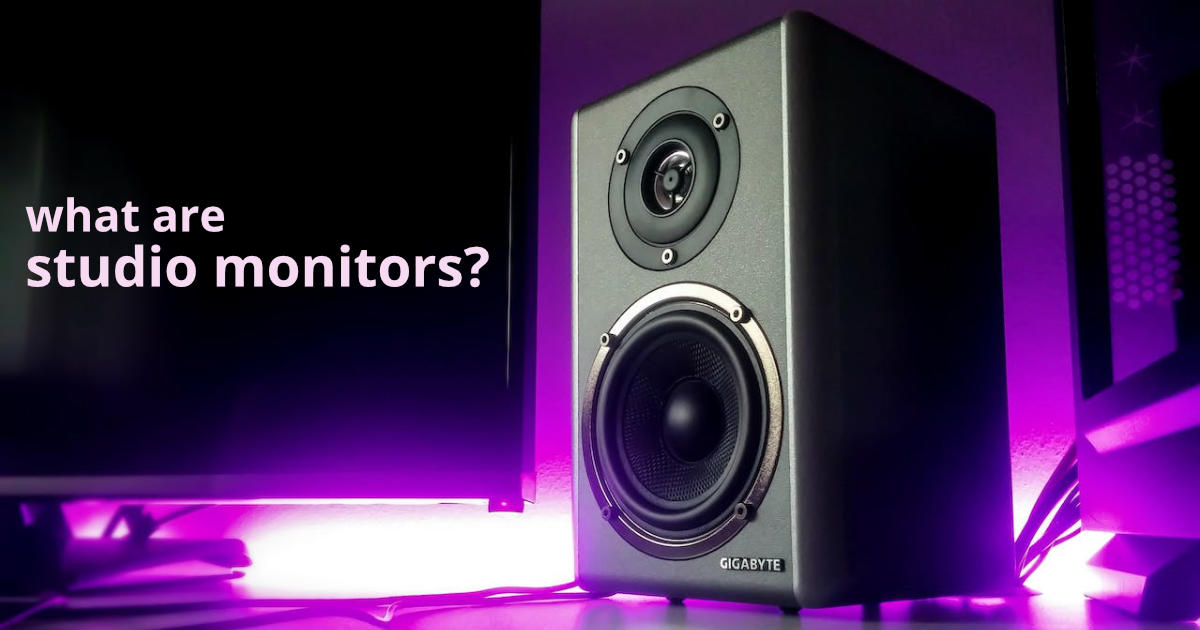Estimated reading time: 9 minutes
Table of contents
Overview
What are studio monitors?
Studio monitors, also known as reference monitors or studio speakers, are specialized speakers designed for audio production and recording purposes. They are an essential tool for musicians, producers, and audio engineers to accurately monitor and evaluate the sound quality of their recordings. Unlike regular speakers, studio monitors are designed to provide a flat frequency response, meaning they reproduce sound without adding any coloration or distortion. This allows users to hear the audio as it truly is, without any enhancements or alterations. Studio monitors come in various sizes and configurations, ranging from compact nearfield monitors to larger midfield and main monitors. They are typically used in recording studios, home studios, and professional audio production environments.
Why are studio monitors important?
Studio monitors are an essential tool for any audio professional or music enthusiast. They are designed to provide accurate and detailed sound reproduction, allowing you to hear every nuance and detail in your audio recordings. Unlike regular speakers, studio monitors are specifically engineered to have a flat frequency response, meaning that they reproduce sound without any added coloration or distortion. This is crucial for mixing and mastering audio, as it allows you to make precise adjustments to the sound. Additionally, monitors often have a higher power output than regular speakers, allowing them to handle the dynamics of music production without distortion or clipping. They also offer a variety of connectivity options, such as XLR and TRS inputs, which ensure compatibility with a wide range of audio equipment. Overall, studio monitors play a vital role in ensuring that your audio projects sound their best.
Different types of studio monitors
Studio monitors come in various types to suit different needs and preferences. Active studio monitors have built-in amplifiers, making them a convenient choice for beginners or those with limited space. On the other hand, passive studio monitors require separate amplifiers, offering more flexibility in terms of customization. Another type to consider is near-field studio monitors, which are designed for close listening and are ideal for small to medium-sized studios. Mid-field and far-field studio monitors, on the other hand, are better suited for larger studios and professional audio production. It’s important to choose the right type of speakers that fits your specific requirements and budget.

Features
Frequency response
The frequency response is one of the most important aspects to consider when choosing studio monitors. It refers to the range of frequencies that the monitors can reproduce accurately. A wider frequency response means that the monitors can accurately reproduce a larger range of audio frequencies, which is crucial for audio mixing. Monitors with a flat frequency response are preferred, as they provide a more accurate representation of the audio being played. It is important to note that different types of music may require different frequency responses, so it is essential to choose monitors that suit your specific needs. Additionally, it is beneficial to consider the room acoustics and size when selecting studio monitors, as they can affect the perceived frequency response. Overall, the frequency response of speakers plays a significant role in ensuring accurate and high-quality audio reproduction for professional audio production.
Get all the info to the question what is normalizing audio?
Power output
The power output of studio monitors is an important factor to consider when choosing the right ones for your setup. It refers to the amount of electrical power that the monitors can handle and deliver to produce sound. Higher power output generally means louder and clearer sound, which is especially important for professional music production. However, it’s also essential to match the power output of the monitors with the size of your studio space to avoid overpowering the room and causing distortion. It’s recommended to consult the specifications of the monitors and consider the power requirements of your audio interface or amplifier. Additionally, some speakers offer adjustable power settings, allowing you to optimize the sound output based on your preferences and the nature of your audio projects.
Connectivity options
When it comes to connectivity options, studio monitors offer a range of choices to suit different needs. Bluetooth connectivity allows for wireless streaming of audio from your devices, while XLR and TRS inputs ensure a reliable and high-quality connection for professional audio equipment. Additionally, some studio monitors also feature USB and RCA inputs, providing even more versatility in connecting various devices. Whether you’re a music producer, sound engineer, or simply enjoy listening to your favorite techno songs of all time, having the right connectivity options is essential for a seamless audio experience.
Check our list of the best 90s techno songs!
Choosing the right studio monitors
Budget considerations
When choosing studio monitors, it’s important to consider your budget. Studio monitors come in a wide range of prices, so it’s crucial to find a balance between quality and affordability. Drag and drop loops are a popular feature in many speakers models, allowing you to easily incorporate pre-recorded loops into your music production. This can be a valuable tool for adding depth and complexity to your tracks. Additionally, consider the long-term investment of studio monitors. While it may be tempting to opt for a cheaper option, investing in higher-quality monitors can greatly improve the accuracy and clarity of your audio. Don’t be afraid to allocate a significant portion of your budget to this essential piece of equipment.
Room size and acoustics
When it comes to choosing the right studio monitors, considering the room size and acoustics is crucial. The size of your room can affect the sound quality and accuracy of the monitors. A smaller room may cause sound reflections and resonance, while a larger room may have more reverb. It’s important to find a balance and create an optimal listening environment. Acoustic treatment such as bass traps and diffusers can help minimize unwanted reflections and improve the overall sound quality. Additionally, understanding the listening position and speaker placement in the room can greatly impact the listening experience. Taking the time to assess and optimize the room size and acoustics will ensure that you get the most out of your studio monitors.
What is Sampling in Music? Understanding the Intricacies of Music Sampling
Listening preferences
When it comes to choosing the right studio monitors, your listening preferences play a crucial role. Every individual has their own unique taste in music and their own preferred sound. Some people prefer a more balanced and neutral sound, while others might prefer a sound that emphasizes certain frequencies. It’s important to consider your musical genre and the type of sound you want to achieve when selecting studio monitors. Additionally, your listening environment should also be taken into account. If you have a small home studio, you might want to opt for compact monitors that can fit in tight spaces.
On the other hand, if you have a larger studio, you have more flexibility in terms of monitor size. Lastly, consider whether you will be using the monitors for critical listening or for casual listening. If you’re a professional audio engineer or producer, you’ll want monitors that provide accurate and detailed sound reproduction. However, if you’re just a music lover who enjoys listening to music, you might prioritize monitors that are more enjoyable and pleasing to the ears. Ultimately, choosing the right studio monitors depends on your personal preferences and the specific requirements of your studio setup.
Conclusion
Importance of studio monitors
Studio monitors play a crucial role in ensuring the artistic integrity of audio productions. These specialized speakers are designed to provide accurate and transparent sound reproduction, allowing producers and engineers to hear every detail and nuance in their music. Unlike consumer speakers, studio monitors are specifically engineered to have a flat frequency response, meaning they reproduce sound without adding any coloration or distortion. This allows music creators to make informed decisions during the mixing and mastering process, ensuring that their final product sounds great on any playback system. Additionally, speakers help in identifying any flaws or imperfections in the audio, enabling the necessary adjustments to be made. Overall, investing in high-quality studio monitors is essential for achieving professional and polished sound quality.
Tips for using studio monitors
When using studio monitors, there are a few tips that can help you get the most out of your listening experience. Firstly, positioning is key. Make sure to place your monitors at ear level and at an equal distance from each other and from your listening position. This will ensure a balanced sound. Secondly, room acoustics play a crucial role. Consider using acoustic treatment to minimize reflections and improve the accuracy of your monitoring. Lastly, don’t forget to take breaks while listening. Fatigue can affect your judgment, so give your ears some rest. By following these tips, you can enhance your studio monitoring experience and achieve the best possible sound quality.
| Topic | Key Information |
|---|---|
| What are Studio Monitors? | Specialized speakers for accurate sound reproduction in audio production and recording. |
| Why Are They Important? | Provide a flat frequency response, allowing precise adjustments. Higher power output for distortion-free dynamics. Various connectivity options. |
| Different Types | Active, passive, near-field, mid-field, and far-field studio monitors to suit various needs. |
| Key Features | Flat frequency response, power output, and connectivity options are crucial for sound quality. |
| Choosing the Right One | Consider budget, room size, acoustics, listening preferences, and room setup. |
| Conclusion | Studio monitors are essential for professional audio quality and music production. Proper setup and care enhance their performance. |
Final thoughts
In conclusion, studio monitors are essential tools for any music producer or audio engineer. They provide accurate and detailed sound reproduction, allowing you to hear every nuance and detail in your music. Whether you’re mixing, mastering, or simply enjoying your favorite tracks, studio monitors ensure that you’re hearing the music as it was intended to be heard. When choosing the right speakers, it’s important to consider your budget, the size and acoustics of your room, and your personal listening preferences. By taking these factors into account, you can find the perfect set of monitors that will enhance your music production experience. So go ahead, invest in a pair of high-quality studio monitors and take your music to the next level!
Do you already have Studio Montiors? Then look also what do you need to make beats.
FAQ
Regular speakers are designed for general listening, adding color and altering sound. Studio monitors, on the other hand, provide a flat frequency response, delivering sound as accurately as possible without distortion or coloration, making them essential for audio professionals.
Select the type of studio monitor based on your room size and listening preferences. Near-field monitors are great for smaller spaces, while mid-field and far-field monitors suit larger studios. Your personal listening preferences, room acoustics, and budget should guide your choice.
Room acoustics can affect sound quality. A smaller room may introduce sound reflections, while a larger room can lead to reverb. Properly treating your room with bass traps and diffusers minimizes unwanted reflections, enhancing the accuracy of your studio monitor’s output.
You can use studio monitors for both casual and professional listening. For professional work, you’ll benefit from the accuracy and detail they provide. However, if you’re a music lover, you can choose speakers that cater to your personal preferences for a more enjoyable listening experience.
Position studio monitors at ear level, equidistant from each other and your listening position. This arrangement ensures a balanced sound. Additionally, invest in room acoustics like bass traps and diffusers to minimize reflections and optimize your monitoring environment.
